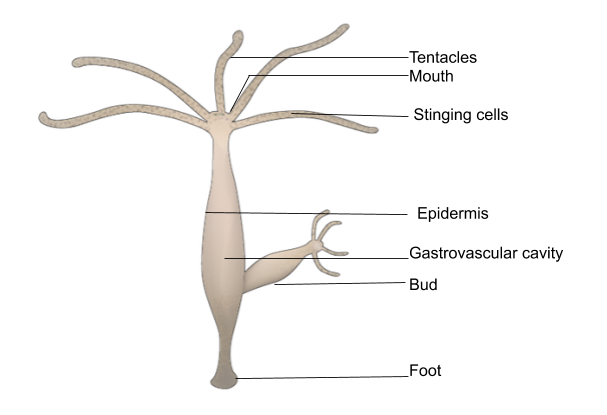
Draw a neat and labelled diagram of Hydra(Coelentarata)
Answer
450.6k+ views
Hint: Hydra is a genus of small, fresh-water organisms in the Cnidaria phylum and Hydrozoa class. The temperate and tropical areas are native to them.Because of their regenerative capacity, biologists are particularly interested in Hydra-they do not appear to die of old age, or indeed to age at all.
Complete answer:
Hydras belong to the phylum Coelenterata, which comprises corals, sea anemones, and jellyfish (also called Cnidaria). Coelenterates are mainly aquatic species, but in freshwater wetlands, lakes, and streams, hydras are present. As part of their life cycle, Hydras are also atypical because they do not have a medusa (jellyfish) period, as do most other coelenterates.
Sexually and asexually, they live and reproduce, but only in the tube-shaped polyp type. They do, however, have the microscopic intracellular stinging capsules characteristic of this phylum and for which it is called, nematocysts or cnidae.
Simple as these species are, one of the animal world's most complex systems is their nematocysts. Hydras have on their tentacles four kinds of nematocysts, which are used for a number of purposes. There are barbs in the largest nematocyst that anchor the prey to the tentacle from which it was shot.
The hydra then envelops the organism with a tight grip on its food, like a sock being pulled over a foot, and consumes it. The second type is smaller and has a shorter, thicker thread of corkscrew that wraps around the prey animal and holds onto it.
A third type has at its end a sticky bean-shaped object that is used in locomotion, securing the hydra as it glides from one position to another or somersaults. There are spines running along the thread in the fourth form of nematocyst and are presumably used to protect the hydra against possible predators.

Note: Hydras eat worms, insect larvae, small crustaceans, larval fish, and other invertebrates; they are predatory.
Prior to eating it, they use their stinging cells to shock, entangle, or kill their prey. Some Hydra species are also known to sting fish to death.
Complete answer:
Hydras belong to the phylum Coelenterata, which comprises corals, sea anemones, and jellyfish (also called Cnidaria). Coelenterates are mainly aquatic species, but in freshwater wetlands, lakes, and streams, hydras are present. As part of their life cycle, Hydras are also atypical because they do not have a medusa (jellyfish) period, as do most other coelenterates.
Sexually and asexually, they live and reproduce, but only in the tube-shaped polyp type. They do, however, have the microscopic intracellular stinging capsules characteristic of this phylum and for which it is called, nematocysts or cnidae.
Simple as these species are, one of the animal world's most complex systems is their nematocysts. Hydras have on their tentacles four kinds of nematocysts, which are used for a number of purposes. There are barbs in the largest nematocyst that anchor the prey to the tentacle from which it was shot.
The hydra then envelops the organism with a tight grip on its food, like a sock being pulled over a foot, and consumes it. The second type is smaller and has a shorter, thicker thread of corkscrew that wraps around the prey animal and holds onto it.
A third type has at its end a sticky bean-shaped object that is used in locomotion, securing the hydra as it glides from one position to another or somersaults. There are spines running along the thread in the fourth form of nematocyst and are presumably used to protect the hydra against possible predators.

Note: Hydras eat worms, insect larvae, small crustaceans, larval fish, and other invertebrates; they are predatory.
Prior to eating it, they use their stinging cells to shock, entangle, or kill their prey. Some Hydra species are also known to sting fish to death.
Recently Updated Pages
Master Class 9 General Knowledge: Engaging Questions & Answers for Success

Master Class 9 English: Engaging Questions & Answers for Success

Master Class 9 Science: Engaging Questions & Answers for Success

Master Class 9 Social Science: Engaging Questions & Answers for Success

Master Class 9 Maths: Engaging Questions & Answers for Success

Class 9 Question and Answer - Your Ultimate Solutions Guide

Trending doubts
According to Bernoullis equation the expression which class 11 physics CBSE

Draw a diagram of nephron and explain its structur class 11 biology CBSE

Differentiate between calcination and roasting class 11 chemistry CBSE

A solution of a substance X is used for white washing class 11 chemistry CBSE

What is spore formation class 11 biology CBSE

10 examples of friction in our daily life




